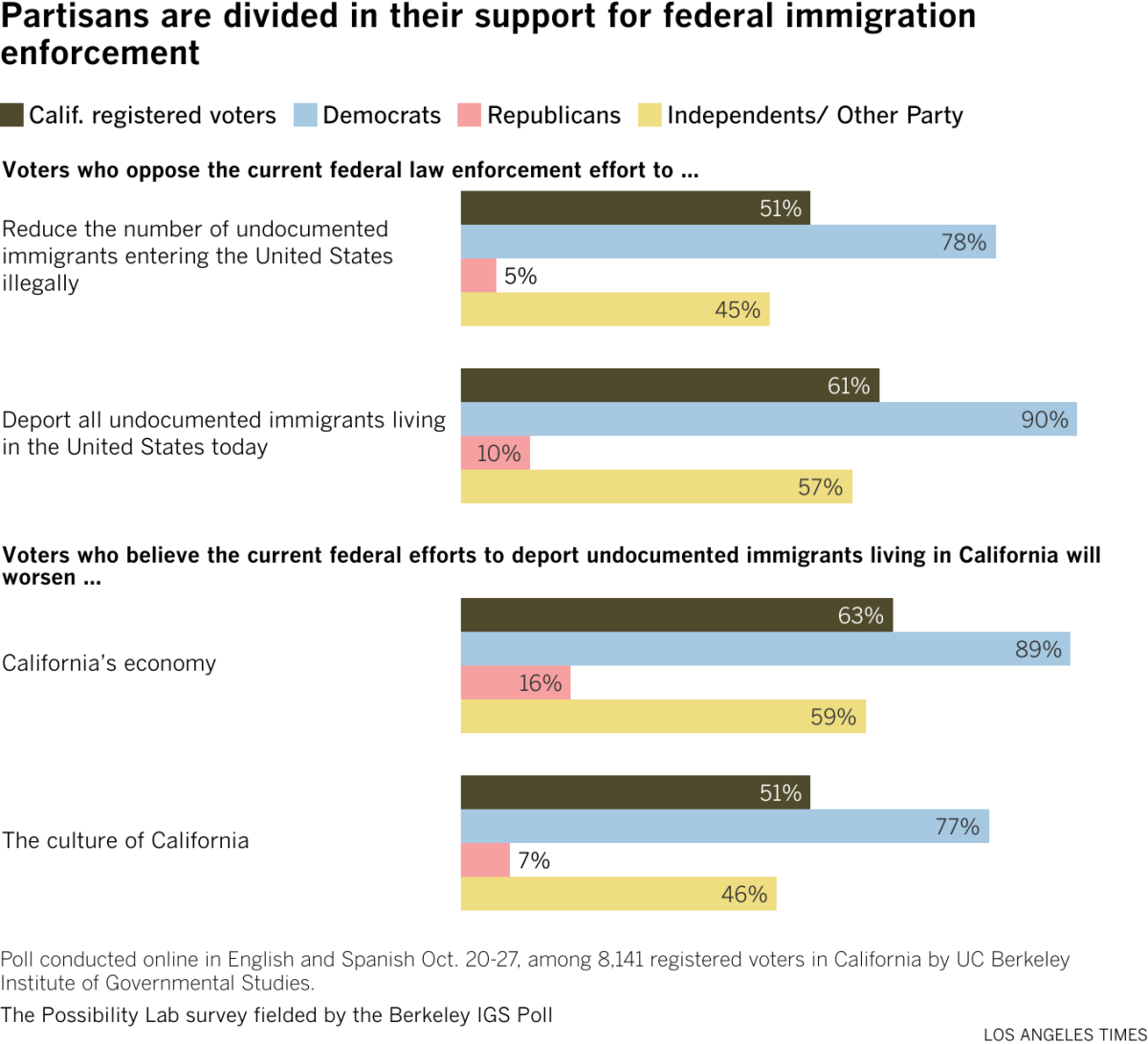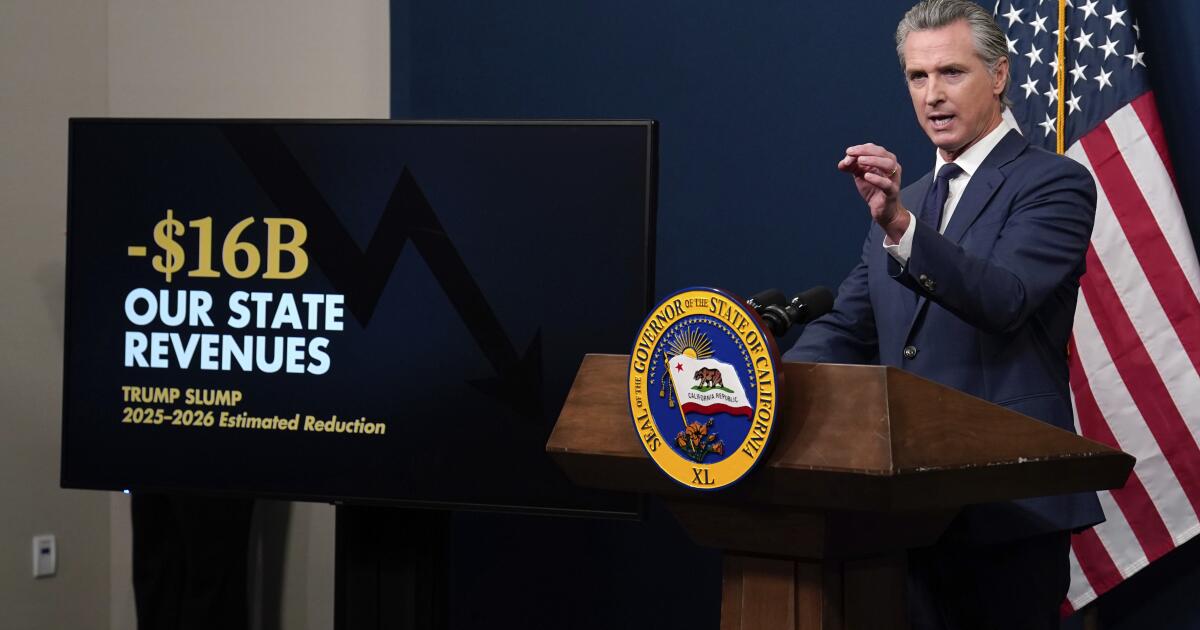Californians sharply divided along partisan lines about immigration raids, poll finds
California voters are sharply divided along partisan lines over the Trump administration’s immigration raids this year in Los Angeles and across the nation, according to a new poll.
Just over half of the state’s registered voters oppose federal efforts to reduce undocumented immigration, and 61% are against deporting everyone in the nation who doesn’t have legal status, according to a recent poll by UC Berkeley’s Possibility Lab released to The Times on Wednesday.
But there is an acute difference in opinions based on political leanings.
Nearly 80% of Democrats oppose reducing the number of people entering the United States illegally, and 90% are against deporting everyone in the country who is undocumented, according to the poll. Among Republicans, 5% are against reducing the entries and 10% don’t believe all undocumented immigrants should be forced to leave.

“The big thing that we find, not surprisingly, is that Democrats and Republicans look really different,” said political scientist Amy Lerman, director of UC Berkeley’s Possibility Lab, who studies race, public opinion and political behavior. “On these perspectives, they fall pretty clearly along party lines. While there’s some variation within the parties by things like age and race, really, the big divide is between Democrats and Republicans.”
While there were some differences based on gender, age, income, geography and race, the results largely mirrored the partisan divide in the state, Lerman said.
One remarkable finding was that nearly a quarter of survey respondents personally knew or were acquainted with someone in their family or friend groups directly affected by the deportation efforts, Lerman said.
“That’s a really substantial proportion,” she said. “Similarly, the extent to which we see people reporting that people in their communities are concerned enough about deportation efforts that they’re not sending their kids to school, not shopping in local stores, not going to work,” not seeking medical care or attending church services.
The poll surveyed a sample of the state’s registered voters and did not include the sentiments of the most affected communities — unregistered voters or those who are ineligible to cast ballots because they are not citizens.
A little more than 23 million of California’s 39.5 million residents were registered to vote as of late October, according to the secretary of state’s office.
“So if we think about the California population generally, this is a really significant underestimate of the effects, even though we’re seeing really substantial effects on communities,” she said.
Earlier this year, U.S. Immigration and Customs Enforcement launched a series of raids in Los Angeles and surrounding communities that spiked in June, creating both fear and outrage in Latino communities. Despite opposition from Gov. Gavin Newsom, Los Angeles Mayor Karen Bass and other elected Democrats, the Trump administration also deployed the National Guard to the streets of the nation’s second-largest city to, federal officials said, protect federal immigration officials.
The months since have been chaotic, with masked, armed agents randomly pulling people — most of whom are Latino — off the streets and out of their workplaces and sending many to detention facilities, where some have died. Some deportees were flown to an El Salvador prison. Multiple lawsuits have been filed by state officials and civil rights groups.
In one notable local case, a federal district judge issued a ruling temporarily blocking federal agents from using racial profiling to carry out indiscriminate immigration arrests in the Los Angeles area. The Supreme Court granted an emergency appeal and lifted that order, while the case moves forward.
More than 7,100 undocumented immigrants have been arrested in the Los Angeles area by federal authorities since June 6, according to the Department of Homeland Security.
On Monday, Rep. Robert Garcia (D-Long Beach), Bass and other elected officials hosted a congressional hearing on the impact of immigration raids that have taken place across the country. Garcia, the top Democrat on the House’s oversight committee, also announced the creation of a tracker to document misconduct and abuse during ICE raids.
While Republican voters largely aligned with Trump’s actions on deportations, 16% said that they believed that the deportations will worsen the state’s economy.
Lerman said the university planned to study whether these numbers changed as the impacts on the economy are felt more greatly.
“If it continues to affect people, particularly, as we see really high rates of effects on the workforce, so construction, agriculture, all of the places where we’re as an economy really reliant [on immigrant labor], I can imagine some of these starting to shift even among Republicans,” she said.
Among Latinos, whose support of Trump grew in the 2024 election, there are multiple indications of growing dissatisfaction with the president, according to separate national polls.
Nearly eight in 10 Latinos said Trump’s policies have harmed their community, compared to 69% in 2019 during his first term, according to a national poll of adults in the United States released by the nonpartisan Pew Research Center on Monday. About 71% said the administration’s deportation efforts had gone too far, an increase from 56% in March. And it was the first time in the two decades that Pew has conducted its survey of Latino voters that the number of Latinos who said their standing in the United States had worsened increased, with more than two-thirds expressing the sentiment.
Another poll released earlier this month by Somos Votantes, a liberal group that urges Latino voters to support Democratic candidates, found that one-third of Latino voters who previously supported Trump rue their decision, according to a national poll.
Small business owner Brian Gavidia is among the Latino voters who supported Trump in November because of financial struggles.
“I was tired of struggling, I was tired of seeing my friends closing businesses,” the 30-year-old said. “When [President] Biden ran again I’m like, ‘I’m not going to vote for the same four years we just had’ … I was sad and I was heartbroken that our economy was failing and that’s the reason why I went that way.”
The East L.A. native, the son of immigrants from Colombia and El Salvador, said he wasn’t concerned about Trump’s immigration policies because the president promised to deport the “worst of the worst.”
He grew disgusted watching the raids that unfolded in Los Angeles earlier this year.
“They’re taking fruit vendors, day laborers, that’s the worst of the worst to you?” he remembered thinking.
Over a lunch of asada tortas and horchata in East L.A., Gavidia recounted being detained by Border Patrol agents in June while working at a Montebello tow yard. Agents shoved him against a metal gate, demanding to know what hospital he was born at after he said he was an American citizen, according to video of the incident.
After reviewing his ID, the agents eventually let Gavidia go. The Department of Homeland Security later claimed that Gavidia was detained for investigation for interference and released after being confirmed to be a U.S. citizen with no outstanding warrants. He is now a plaintiff in a lawsuit filed by the ACLU and immigrant advocacy groups alleging racial profiling during immigration raids.
“At that moment, I was the criminal, at that moment I was the worst of the worst, which is crazy because I went to go see who they were getting — the worst of the worst like they said they were going to get,” Gavidia said. “But turns out when I got there, I was the worst of the worst.”





